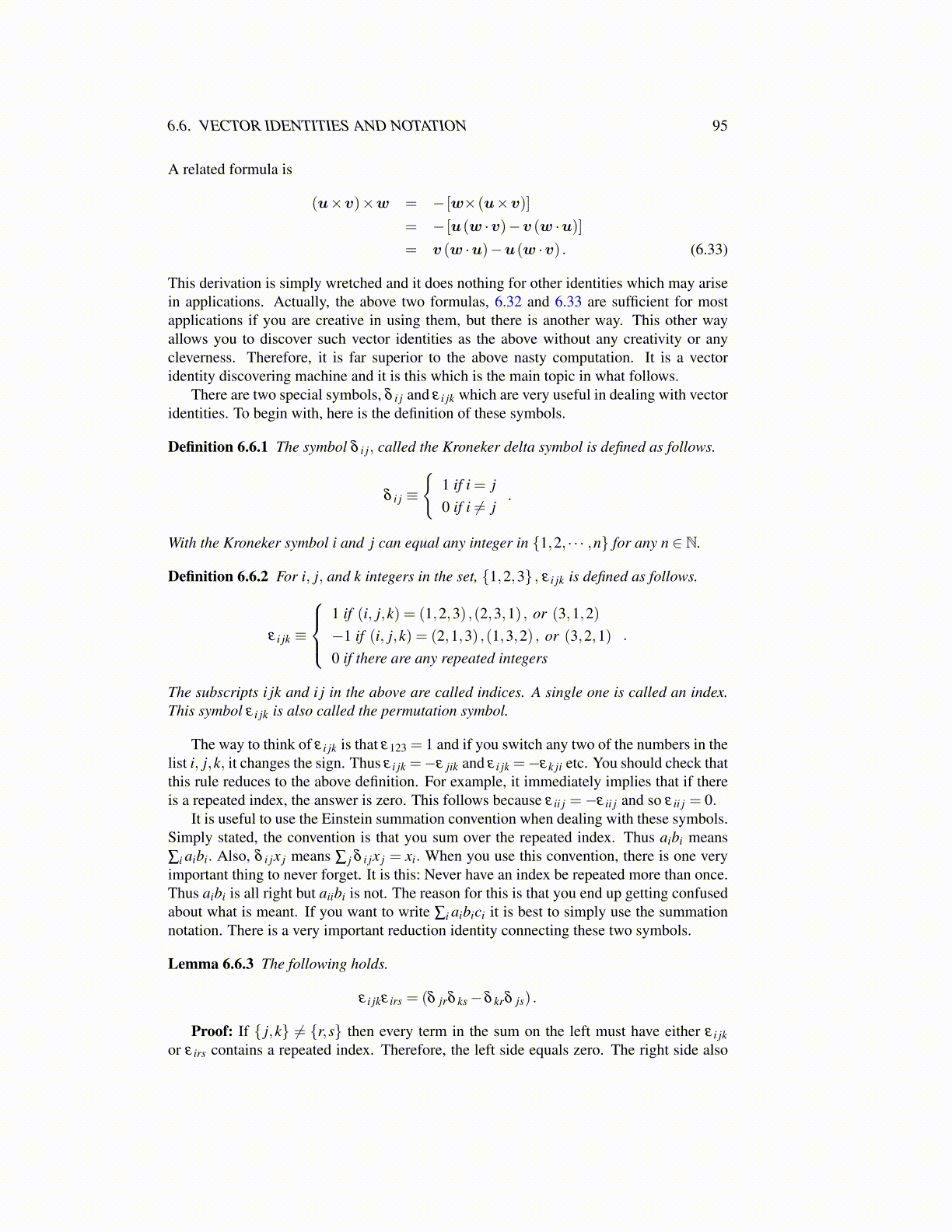
6.6. VECTOR IDENTITIES AND NOTATION 95
A related formula is
(u×v)×w = − [w×(u×v)]
= − [u(w ·v)−v (w ·u)]= v (w ·u)−u(w ·v) . (6.33)
This derivation is simply wretched and it does nothing for other identities which may arisein applications. Actually, the above two formulas, 6.32 and 6.33 are sufficient for mostapplications if you are creative in using them, but there is another way. This other wayallows you to discover such vector identities as the above without any creativity or anycleverness. Therefore, it is far superior to the above nasty computation. It is a vectoridentity discovering machine and it is this which is the main topic in what follows.
There are two special symbols, δ i j and ε i jk which are very useful in dealing with vectoridentities. To begin with, here is the definition of these symbols.
Definition 6.6.1 The symbol δ i j, called the Kroneker delta symbol is defined as follows.
δ i j ≡
{1 if i = j0 if i ̸= j
.
With the Kroneker symbol i and j can equal any integer in {1,2, · · · ,n} for any n ∈ N.
Definition 6.6.2 For i, j, and k integers in the set, {1,2,3} , ε i jk is defined as follows.
ε i jk ≡
1 if (i, j,k) = (1,2,3) ,(2,3,1) , or (3,1,2)−1 if (i, j,k) = (2,1,3) ,(1,3,2) , or (3,2,1)0 if there are any repeated integers
.
The subscripts i jk and i j in the above are called indices. A single one is called an index.This symbol ε i jk is also called the permutation symbol.
The way to think of ε i jk is that ε123 = 1 and if you switch any two of the numbers in thelist i, j,k, it changes the sign. Thus ε i jk =−ε jik and ε i jk =−εk ji etc. You should check thatthis rule reduces to the above definition. For example, it immediately implies that if thereis a repeated index, the answer is zero. This follows because ε ii j =−ε ii j and so ε ii j = 0.
It is useful to use the Einstein summation convention when dealing with these symbols.Simply stated, the convention is that you sum over the repeated index. Thus aibi means∑i aibi. Also, δ i jx j means ∑ j δ i jx j = xi. When you use this convention, there is one veryimportant thing to never forget. It is this: Never have an index be repeated more than once.Thus aibi is all right but aiibi is not. The reason for this is that you end up getting confusedabout what is meant. If you want to write ∑i aibici it is best to simply use the summationnotation. There is a very important reduction identity connecting these two symbols.
Lemma 6.6.3 The following holds.
ε i jkε irs = (δ jrδ ks−δ krδ js) .
Proof: If { j,k} ̸= {r,s} then every term in the sum on the left must have either ε i jkor ε irs contains a repeated index. Therefore, the left side equals zero. The right side also